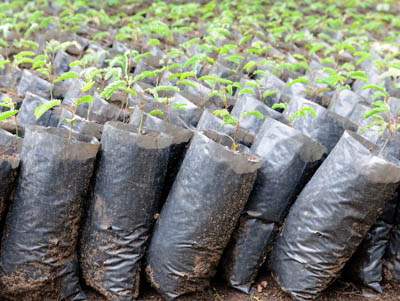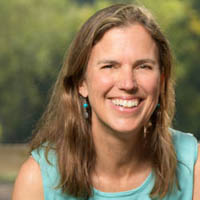10 Questions All Funders Should Ask Before Supporting Tree-Planting Campaigns
In recent years, as the impacts of climate change have become more pronounced, tree-planting has frequently been touted as a “natural climate solution” to capture and store planet-warming carbon dioxide emissions while also conserving biodiversity and improving quality of life for people.
In recent years, as the impacts of climate change have become more pronounced, tree-planting has frequently been touted as a “natural climate solution” to capture and store planet-warming carbon dioxide emissions while also conserving biodiversity and improving quality of life for people.

Seedlings like these are used for tree-planting campaigns that aim to deliver a host of environmental and social benefits. But these efforts require careful planning and long-term maintenance and investment in order to succeed.
Environmental Studies Professor Karen Holl, who has been studying forest restoration for almost three decades, can attest to the importance of protecting existing forests and restoring tree cover where it has been lost. But true forest restoration is a complex endeavor that requires careful planning and long-term maintenance and investment.

Environmental Studies Professor Karen Holl
Holl and her frequent research collaborator, Professor Pedro Brancalion at the University of São Paulo in Brazil, have become concerned that widespread fervor for tree-planting may be leaving restoration best-practices by the wayside. Tree-planting efforts have grown to fad proportions, with large-scale organized campaigns, carbon offset credits, corporate responsibility pledges, and individual donors all contributing to a largely unregulated global undertaking.
“There are billions of dollars being dedicated to this, and if we want to realize positive outcomes, it is important to think carefully about where all of that money is going,” Holl said. “Otherwise, the risk is that we could be wasting money on projects that will either fail or, worse, have harmful effects.”
That’s why Holl and Brancalion recently published the following set of research-based questions that all potential funders should ask before deciding to support a reforestation campaign:
- What do you hope to achieve by growing trees?
- Do the proposed tree growing strategies match those goals?
- How have the initial drivers of deforestation and forest degradation been assessed and resolved?
- How are local stakeholders involved in the project?
- What benefits will they receive?
- How will potential negative consequences of the project be minimized?
- How will the project be maintained and supported after the first few years?
- How will the outcomes of the project be monitored and guide adaptive management?
- What are the outcomes of prior tree growing efforts overseen by this organization?
- How will the funding be allocated across organizational scales?
Even when projects go right, there are usually trade-offs among goals like carbon sequestration, biodiversity, and benefits to local stakeholders, which is why it’s important to have a clear vision early on. Funders must also be realistic about what tree-planting can accomplish.
“Everyone wants to plant our way out of climate change, but trees are not a substitute for the need to make large and rapid reductions in global greenhouse gas emissions,” Holl said.
Holl and Brancalion also want to make sure that tree-planting groups are planning for the long term. Research shows that poorly-planned tree-planting efforts often fail to produce desired benefits because the trees don’t survive long enough. So, instead of measuring impact by the number of trees planted, projects should set targets for how many trees will be alive in five, 10, or 20 years, and then collect data on the results. This type of monitoring is essential to identifying and correcting issues as tree-planting efforts continue to grow in scale.
The number of organizations leading these projects has grown rapidly too, and not all have the same level of experience or qualifications. Some of the recommended questions can help funders get a better sense for the track record of organizations they’re considering supporting. Often, a large global intermediary organization secures funding for smaller implementing organizations, in which case it’s also important to understand how funding is distributed, to ensure that local stakeholders will be sufficiently compensated.
Holl has asked these questions for herself while serving on advisory boards for investment groups and environmental organizations. She and her students are also starting to systematically evaluate how well different tree growing organizations can answer. If others start asking these questions too, she hopes that funding for forest restoration projects can be put to its most productive uses.
“I’m always looking for organizations to clearly state their goals, to have a long-term plan, and to tell me how their project is stakeholder-led,” she said. “These are all questions that organizations should be able to answer, and that is a key to success.”
Original Story Source: Uc Santa Cruz

 Alerts Sign-up
Alerts Sign-up